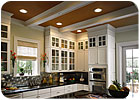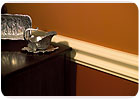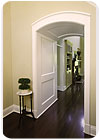
Molding and millwork are often referred to as the icing on the cake. After the walls and ceilings are finished, detailed moldings are put in place to top off the job and make a dramatic visual statement that everyone remembers.
“Molding and millwork is king in the perceived value arena,” said Kellie Schroeder, executive director of the Wood Moulding and Millwork Producers Association. “Moldings create an instant sense of comfort and depth, and are always visually stunning to the eye. Moldings are a very small detail in the overall design of a home, but they are a detail that most potential homebuyers notice the instant they walk into a room.”
For 2007, the molding and millwork market is expected to be in a transition year, as new competitors enter the interior market, new building practices take form and manufacturers regroup for the next housing boom.

Urethane chair rail molding
THE RISE OF PVC
Wood has historically been the material of choice for interior moldings, but alternative materials like polyurethane and PVC are making bigger inroads, and in turn the market is attracting more competitors.Sensing an opportunity, exterior molding manufacturers are increasingly directing their efforts toward developing product for interior usage.
“Gossen Mouldings, which primarily manufactures PVC products for exterior use, is seeing increased demand for interior trims, such as casings and crown moldings,” said Bob Simon, executive vice president of Gossen Corp. “That demand is from people who want low-maintenance moldings and who value the solid color aspect of cellular PVC. We expect that in 2007, a greater percentage of our production will be dedicated to manufacturing moldings for interior use.”
Azek Trimboards is another exterior PVC producer that is receiving an increasing number of inquiries about using its products inside the house. While the company is not specifically targeting the interior molding market, it does offer products that can be used indoors.
“While the real value of our products are on the exterior of a home, we do have requests to use the moldings in interior applications because our product is durable and is built to resist moisture,” said Maureen Murray, spokesperson for Azek Trimboards. “We had one builder in Santa Cruz, Calif., who wanted to use our product in an interior application because the moisture content in the area is so high.”

Fypon PVC trim and board products used to make a foyer arch transition from one room to another.
CROWN IS STILL KING
Consumer trends normally change like the ocean tide; however, interior molding styles and designs have managed to maintain a constant set of favorites among homeowners.The classic, traditional molding concepts continue to attract the majority of attention, according to Kaye Evans, director of marketing at Royal Mouldings.
“Crown molding still takes precedence over everything else,” said Evans. “Homeowners still can’t believe that they can afford crown molding. The hardest message to get out there is that it’s not expensive.”
Kathy Ziprik, a spokesperson for Fypon, a leading manufacturer of both polyurethane and PVC moldings, agrees that crown molding is the most popular style for use in the home, but also says consumers are branching out.
“Fypon introduced a line of art deco moldings recently that people seem to like a lot,” she said. “The moldings are reminiscent of the styles of the 1920s and 1930s. Art deco moldings use popular elements such as rounded corners, stepped forms and geometrical rhythm. Clean lines and simple formats create designs that replicate art deco styles made popular years ago.”
Other interior items of popularity include small wall niches (for the foyer, bathroom, and bedroom) and faux beams for use on ceilings or as mantels.
“Faux wood beams add drama and character to the ceiling of any room,” said Ziprik, adding that beams, some running as long as 20 feet in length, are available in wood grains similar to those of cedar, white ash and red oak and, once stained, resemble real wood. Significantly lighter in weight than real wood beams, urethane beams have a hollow interior, making them easy to install.”
The drive behind alternative materials is ease of use, added Ziprik, and homeowners looking for low maintenance products.
“Consumers are moving in low-maintenance directions for all items in the home, so we’re seeing ceiling medallions, decorative brackets and domes doing extremely well over the past year or so,” said Ziprik. “Another reason urethane products are popular is that they can easily be faux finished, allowing homeowners to customize the look of the items to match their overall decor.”
WAINSCOTING CATCHING ON
Wainscoting, or decorative paneling that commonly adorns the lower part of walls and stairways, adds architectural interest and detail to otherwise bare walls. This treatment is gaining market share as homeowners look for additional decorative features.“Wainscoting is catching on more and more,” said Evans. “It’s a very traditional look and feel. In modern homes, a growing trend is using chair rail and building in a beaded bottom or using decorative paper below the molding. These are examples of using the technique in a very different way than what it was originally designed for.”
Azek’s Murray says the wainscoting technique is the most popular request the company receives.
“When professionals come to us wanting to use our moldings on the interior it’s mainly because they want the look of our wainscoting,” she said. “Wainscoting adds class. It looks like a farmhouse but a lot dressier and adds a decorative value that is easy to install.”
BUILD-UPS ON THE RISE
Added customization is also entering the molding market as homeowners continue to seek ways to set their homes apart from the crowd. Not satisfied with the look of just one piece of molding, homeowners are asking for combinations of moldings, or build-ups, to achieve a look that would not be possible with a single molding. This practice of “building up” allows homeowners to create unique looks and is an opportunity for wall and ceiling companies to increase molding volumes involved in a job.“Build-ups are definitely a consumer trend right now,” said Royal Molding’s Evans. “We’re seeing this more and more on the ceiling as well as on the baseboard. The process makes a grand presence. The big box retailers are really promoting this style now also.”
WMMPA’s Schroeder agrees and thinks this process will be a big part of the market in 2007 in all types of homes.
“We’re seeing a surge in high-end remodeling as related to molding and millwork products,” she said. “Homeowners are refinancing and reinvesting those dollars into their dwellings. Fifteen years ago, the remodeler would take their extra cash and invest in a 4- to 5-inch oak crown molding for their home as a nice upgrade. Now, we have two trends going. The first trend is to purchase a 5-inch oak crown molding and build up that profile to create an elaborate ceiling display. The second trend is to invest in an 11-inch MDF crown molding – with or without build-ups – which creates a dramatic visual to any room it is installed within.”
GREEN BUILDING
The process of “green” building is rapidly gaining traction in the home building industry. While still not specifically defined, green building is moving into the molding marketplace as well. Several molding producers are preparing environmental statements that address manufacturing processes, recycling and natural resource protection in order to provide information when asked by homeowners and contractors.“Green building is a big trend in all aspects of home building right now,” said Evans. “Anything to do with sustainability is popular. One reason is that as the home building industry has slowed a little it is turning to new ways to increase business. Green building has always been around but has been unnoticed by builders. Now they’re looking to do good for the world as well as their businesses.”
Evans said Royal Mouldings is taking the green movement seriously and has made good progress with developing a sustainable product that could be introduced later this year.
THE 2007 MARKET
Although the WMMPA expects an overall softer market for moldings and millwork in 2007, it will be a steady market for the manufacturers.“Housing starts have slid, but not as sharply as most predicted,” said Schroeder. “There are still large pockets of ferocious building dappled across the United States, with steady starts smoothed out across the nation. Another bright spot is the remodeling market is still energized. More and more homeowners are opting to upgrade their current home rather than try to sell in this buyer’s market. Our industry will certainly not see the volume and rapid pace of 2004-05 this year, but will maintain decent production levels.”
With the slowdown, Schroeder says manufacturers will utilize this time to re-tool, conduct more thorough maintenance programs of their equipment and explore the possibility of new product lines.
“The overheated markets of 2004-05 did not allow a lot of time for equipment upgrades and product development since most manufacturers were running a minimum of two shifts seven days a week to keep up with demand,” she said. “This relaxing in the market affords the manufacturers a bit of breathing room to ready themselves for future high-demand periods in the market.”
Sidebar: WMMPA welcomes PVC producers
Due to the growing popularity of non-wood moldings in the marketplace, the Wood Moulding and Millwork Producers Association voted last year to allow non-wood molding manufacturers to join its organization.The WMMPA voted to open its doors to PVC molding manufacturers in February 2006, and started a recruitment effort in July 2006 to find companies for its new Poly Blend Group.
“The wood and MDF molding manufacturers are excited to welcome in their PVC counterparts to the table for broad discussions regarding the molding and millwork industry,” said WMMPA Executive Director Kellie Schroeder.
So far, Schroeder says that the WMMPA has attracted a lot of interest from the PVC industry by providing a platform for sharing of information for these manufacturers. The goal, she says, is to bring the PVC companies together at one table to achieve industry standards and open discussions regarding their specific market goals and data sharing.
“The Poly Blends Group is still in its infancy, but the WMMPA staff has logged numerous calls from inquiring PVC manufacturers regarding membership and participation within the group,” said Schroeder.
To date, the WMMPA has managed to attract several large manufacturers in the PVC industry as members, such as Gossen Mouldings, and is hoping that others will follow.


